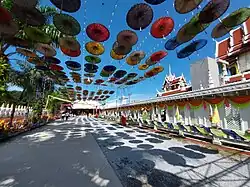Wat Chedi Ai Khai
| Wat Chedi (Ai Khai) | |
|---|---|
วัดเจดีย์ (ไอ้ไข่) | |
 | |
| Religion | |
| Affiliation | Buddhism |
| Sect | Theravāda, Maha Nikāya |
| Deity | Ai Khai (ไอ้ไข่) |
| Location | |
| Country | Thailand |
| Geographic coordinates | 8°54′40″N 99°50′48″E / 8.91111°N 99.84667°E |
| Website | |
| https://xn--22cl9ab4e0a0c1a3b9g1bb7cl6b.net/ | |
Wat Chedi (Ai Khai) (วัดเจดีย์ (ไอ้ไข่)), commonly known as Wat Chedi Ai Khai, is a Buddhist temple located in Chalong Subdistrict (ตำบลฉลอง, *Tambon Chalong*), Sichon District (อำเภอสิชล, *Amphoe Sichon*), Nakhon Si Thammarat Province (จังหวัดนครศรีธรรมราช), Thailand. The temple is widely known for the veneration of Ai Khai (ไอ้ไข่), the spirit of a boy who is believed to protect the temple and grant blessings to devotees.
History and Legend
The name "Ai Khai" originates from a boy who accompanied the revered monk Luang Pu Thuat (หลวงปู่ทวด) during his journey from Songkhla Province (จังหวัดสงขลา) to the Ayutthaya Kingdom (กรุงศรีอยุธยา). According to local legend, during the late Ayutthaya period, Luang Pu Thuat traveled with a boy aged about 9 or 10 years old, intending for him to serve the monk.
Upon arriving at the site of the temple, Luang Pu Thuat stopped and waited to meet Khrua Thong (ขรัวทอง), the abbot of the temple in Nakhon Si Thammarat, who was a fellow Buddhist scholar. Recognizing the spiritual importance of the location, Luang Pu Thuat instructed the boy to remain there to protect the temple and its teachings.[1]
Local chronicles recount that the boy was mischievous but endowed with supernatural powers, assisting the villagers in various troubles. To prevent being taken away by Luang Pu Thuat on his return journey, Ai Khai is said to have ended his physical life by entering the temple pond, leaving his spirit behind to watch over the temple to this day.
Legend According to Khun Phantharak Ratchadet
The temple and nearby community have revered Ai Khai as a guardian spirit for several centuries. In the mid-20th century, the prominent occultist Khun Phantharak Ratchadet (ขุนพันธรักษ์ราชเดช) learned of Ai Khai through spiritual mediums while involved in the creation of Luang Pu Thuat amulets. He investigated the legend further and confirmed the identity of Ai Khai through local acquaintances.[2][3]
Statues of Ai Khai
Originally, the temple lacked a physical statue of Ai Khai. Later, a local occultist named Phu Yai Thieng Mueang In (ผู้ใหญ่เที่ยง เมืองอินทร์), renowned for his occult skills and metal bending abilities, carved the first wooden statue from coral tree wood. Due to natural decay, he later carved a teakwood statue in 1982, which depicts Ai Khai as a naked boy with his right fist raised to his chest. This statue is now enshrined in the temple and is the focal point of worship.[4][5]
Veneration and Influence
From an abandoned site, Wat Chedi has grown into a major center of faith and tourism. Devotees from across Thailand and abroad come to seek blessings from Ai Khai, who is regarded as a powerful spirit that grants wishes, protects the faithful, and aids those in distress.
The popular phrase among worshippers is: "If you ask, you shall receive."
The temple has developed its infrastructure significantly, including construction of an ubosot (ordination hall), viharn (assembly hall), and other facilities to accommodate the increasing number of visitors.[6]
Worship Practices
During the annual Songkran Festival (April 13–17), the temple committee organizes merit-making ceremonies where the statue of Ai Khai is ceremoniously bathed by devotees. People come to pour water, offer prayers, and make wishes with deep faith.
In 1983, the first Ai Khai amulets were created. There are stories of military personnel stationed at the temple who experienced playful spiritual disturbances from Ai Khai, which ceased after offerings were made.[7]
Naming
The name "Ai Khai" remains widely used due to the longstanding tradition and familiarity among devotees, despite the passage of many generations.
References
- ^ วัดเจดีย์, นิทรรศการตำนานวัดเจดีย์, นครศรีธรรมราช. Retrieved July 8, 2020 (in Thai).
- ^ Legend of Ai Khai, the Wat Chedi Guardian Spirit, Sanook.com. Retrieved July 11, 2020 (in Thai).
- ^ วัดเจดีย์, นิทรรศการตำนานวัดเจดีย์ภาพ 2, นครศรีธรรมราช. Retrieved July 8, 2020 (in Thai).
- ^ วัดเจดีย์, นิทรรศการตำนานวัดเจดีย์ภาพ 3 (รูปไม้แกะที่ 1), นครศรีธรรมราช. Retrieved July 8, 2020 (in Thai).
- ^ วัดเจดีย์, นิทรรศการตำนานวัดเจดีย์ภาพ 4 (รูปไม้ตะเคียนแกะที่ 2), นครศรีธรรมราช. Retrieved July 8, 2020 (in Thai).
- ^ Wat Chedi, Official site. Retrieved July 11, 2020 (in Thai).
- ^ Legend of Ai Khai, Archive.org. Retrieved July 11, 2020 (in Thai).